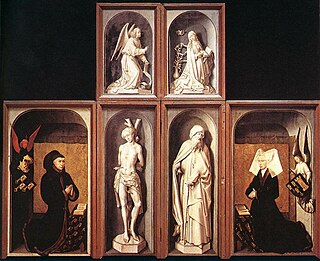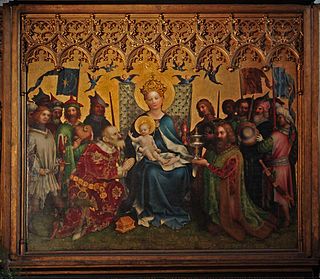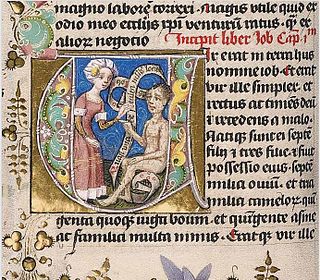
A polyptych is a painting which is divided into sections, or panels. Specifically, a diptych is a two-part work of art; a triptych is a three-part work; a tetraptych or quadriptych has four parts, whereas a polyptych describes any work of art formed of more than one constitutive part.

Stefan Lochner was a German painter working in the late International Gothic period. His paintings combine that era's tendency toward long flowing lines and brilliant colours with the realism, virtuoso surface textures and innovative iconography of the early Northern Renaissance. Based in Cologne, a commercial and artistic hub of northern Europe, Lochner was one of the most important German painters before Albrecht Dürer. Extant works include single-panel oil paintings, devotional polyptychs and illuminated manuscripts, which often feature fanciful and blue-winged angels. Today some thirty-seven individual panels are attributed to him with confidence.

The Wallraf–Richartz Museum is an art museum in Cologne, Germany, with a collection of fine art from the medieval period to the early twentieth century. It is one of the three major museums in Cologne.

The Mérode Altarpiece is an oil on oak panel triptych, now in The Cloisters, in New York City. It is unsigned and undated, but attributed to Early Netherlandish painter Robert Campin and an assistant. The three panels represent, from left to right, the donors kneeling in prayer in a garden, the moment of the Annunciation to Mary, which is set in a contemporary, domestic setting, and Saint Joseph, a carpenter with the tools of his trade. The many elements of religious symbolism include the lily and fountain, and the Holy Spirit represented by the rays of light coming through from the central panel's left hand window.

The Maestà, or Maestà of Duccio, is an altarpiece composed of many individual paintings commissioned by the city of Siena in Tuscany in 1308 from the artist Duccio di Buoninsegna and is his most famous work. Duccio's the Maestà was originally composed with a front and back side that relied on each other to encompass the full knowledge of the altarpiece. This was the first altarpiece to contain both a front and back side. The front panels make up a large enthroned Madonna and Child with saints and angels, and a predella of the Childhood of Christ with prophets.

The Beaune Altarpiece is a large polyptych c. 1443–1451 altarpiece by the Early Netherlandish artist Rogier van der Weyden, painted in oil on oak panels with parts later transferred to canvas. It consists of fifteen paintings on nine panels, of which six are painted on both sides. Unusually for the period, it retains some of its original frames.

The Coronation of the Virgin or Coronation of Mary is a subject in Christian art, especially popular in Italy in the 13th to 15th centuries, but continuing in popularity until the 18th century and beyond. Christ, sometimes accompanied by God the Father and the Holy Spirit in the form of a dove, places a crown on the head of Mary as Queen of Heaven. In early versions the setting is a Heaven imagined as an earthly court, staffed by saints and angels; in later versions Heaven is more often seen as in the sky, with the figures seated on clouds. The subject is also notable as one where the whole Christian Trinity is often shown together, sometimes in unusual ways. Crowned Virgins are also seen in Eastern Orthodox Christian icons, specifically in the Russian Orthodox church after the 18th century. Mary is sometimes shown, in both Eastern and Western Christian art, being crowned by one or two angels, but this is considered a different subject.

The Master of the Heisterbach Altarpiece was a German painter active around Cologne between 1440 and 1460.
The Master of the Pallant Altarpiece was a German painter, active in Cologne around 1430. His work shows traces of the influence of Stefan Lochner. His name is derived from an altarpiece, dated 1425, donated by Werner II of Pallant to the parish church of Linnich.

The Barbadori Altarpiece is a painting by Filippo Lippi, dated to 1438 and housed in the Louvre Museum of Paris.

The Cologne School of Painting is a style of painting. The term was first applied in the 19th century to describe old German paintings generally. It subsequently came to refer more specifically to painters who had their workshops in medieval Cologne and the lower-Rhine region from about 1300 to 1550.

Madonna of the Rose Bower is a panel painting by the German artist Stefan Lochner, usually dated c. 1440–1442, although some art historians believe it contemporaneous with his later Dombild Altarpiece. It is usually seen as one of his finest and most closely detailed works.

The Saint Columba Altarpiece is a large c. 1450–1455 oil-on-oak wood panel altarpiece by Early Netherlandish painter Rogier van der Weyden painted during his late period. It was commissioned for the church of St. Columba in Cologne, and is now in the Alte Pinakothek, Munich. It depict scenes from the early life of Jesus. They show, from left to right, the Annunciation, the Adoration of the Magi and the Presentation, when she presents the infant at the Temple in Jerusalem. In each panel, Mary is distinguished by her blue clothes. The reverse of the exterior panels are covered with plain paint and lack indication that they ever contained donor portraits as were typical for the time.

Presentation of Christ in the Temple is a painting by the German artist Stefan Lochner, created c. 1447. it is held in the Calouste Gulbenkian Foundation, in Lisbon. It was once the wing of a diptych, the opposite, now separated, panel was a depiction of the Nativity. Its reverse shows the Stigmatisation of St. Francis. The panel is dedicated to St. Catherine and shows the purification of the Virgin. It is the first of two of Lochner's treatments of the subject - a larger painting completed two years later is kept at the Hessisches Landesmuseum, Darmstadt, Germany. The two panels are the only known dated paintings left by Lochner.

Last Judgement is a c. 1435 tempera-on-oak polyptych by the German artist Stefan Lochner, probably commissioned for the council chamber of City Hall of Cologne, but now broken apart. Today the outer wings, which formed a sixfold partition when extended, have been sawed off into twelve individual pictures, most of which are still extant but held in separate collections, mostly in Cologne, Munich and Frankfurt. The interior wings included the Martyrdom of the Apostles, the exterior panels comprised in part of the Saint Anthony Abbot, Mary Magdalene and a Donor, Saints Catherine, Hubert, Quirinus of Neuss, and a Donor, and Pope Cornelius. Its depiction of the Last Judgment follows many of the conventions of contemporary doom paintings, but Lochner introduces important innovations, especially in his rendering of the angel's black and flowing clothes.

The Prayer book of Stefan Lochner is an illuminated manuscript attributed to the German artist Stefan Lochner. Dated to the early 1450s, the Book of hours consists of 235 leaves, each folio measuring 108 x 80mm. The extent of Lochner's involvement is debated; workshop members were probably heavily engaged in its production. However, his style, or at least that of his followers, can be detected in the overall layout; the colourisation, vivid and harmonious flowers in the borders, and the delicate treatment of the foliage are all characteristic of his style.

The Adoration of the Magi Altarpiece is a painted triptych by the German artist Stefan Lochner, created c. 1440–1442. Originally painted for the council-chapel St. Maria in Jerusalem in Cologne, it was moved to Cologne Cathedral in 1810 and is now in that church's Marienkapelle, south of the choir. It is also known as the Three Kings Altarpiece (Dreikönigsaltar) and the Patron Saints of Cologne Altarpiece.

The Master of the Holy Kinship the Younger is a German painter of the Middle Ages who was active between 1475 and 1515 in Cologne and its environs. He is designated "The Younger" to distinguish him from another Master, given the same name, who worked in that area from 1410 to 1440.

Madonna of the Rose Bower is a monumental 1473 panel painting by the German artist, Martin Schongauer, depicting Mary and Christ Child in a hortus conclusus, surrounded by roses and finches. The painting is kept in the former Dominican Church of Colmar in Alsace, a large Gothic church formerly of the Dominican Order, built in the 13th and 14th century. It is classified as a Monument historique, as an object, by the French Ministry of Culture since 1978.



















